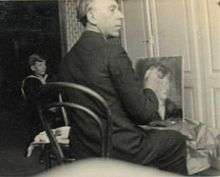Léon Zack
Léon Zack (1892 – 1980), also known as Lev Vasilevich Zak, was a Russian-born French figurative and later abstract painter and sculptor.[1] He has been described as a School of Paris painter.
Léon Zack | |
|---|---|
 | |
| Born | 12 July 1892 Nijni-Novgorod, Russia |
| Died | 30 March 1980 (aged 87) Vanves, France |
| Nationality | Russian |
Biography
Léon Zack was born into a Jewish family in Nijni-Novgorod in Russia on 12 July 1892, to a pharmacist father.[2][3] He was an illustrator, painter, designer and sculptor. He has been described a School of Paris painter.[4] He was painting at the age of 13 and exhibiting his work by 15, being a pupil of Jakimchenko from 1905 to 1907.[5] Whilst studying literature at the University of Moscow, he took painting and drawing classes at private academies where he studied under post-Impressionists such as Mashkov.[3] After leaving Russia in 1920, he spent time in Florence, Rome and Berlin, before settling in Paris in 1923.[6][7] Whilst in Berlin, he designed costumes and sets for the Ballets Romantiques Russes.[6]
In 1926, Zack had his first one-man show in Paris, painting figures including harlequins and gypsies. He exhibited at the Salon d'Automne and the Salon des Indépendants and took French citizenship in 1938.[8] He lived at Villefranche-sur-Mer during World War II. By 1947, he was back in Paris designing sets for the Opéra-Comique and in the 1950s he designed stained glass windows, including for Notre Dame des Pauvres at Issy-les-Moulineaux. Around this time Zack's work abandoned figuration for geometrical abstraction, gradually moving toward a more expressive mode of Tachisme. He had exhibitions of such abstract works at the Galerie Kléber in 1955 and 1957.[8] At the end of his life, he lived on the outskirts of Paris and died in Vanves on 30 March 1980.[4]
Zack has work in British national collections, including the Tate Collection, the Ashmolean Museum of Art and Archaeology and the Sainsbury Centre for Visual Arts at the University of East Anglia.[4][9]
Selected exhibitions
- from 1923: Salon d’Automne, Paris[3]
- 1926: Galerie d’Art Contemporain, Paris[6]
- 1927: Galerie Percier, Paris[10]
- 1928: Art Institute of Chicago, Chicago
- 1935: Galerie Wildenstein, Paris
- 1946: Galerie Katia Granoff, Paris
- 1959: Waddington Galleries, London
- 1976: Léon Zack, Musée d'Art Moderne de la Ville de Paris, Paris[11]
- 1988: Léon Zack retrospective: 1892-1980, Musée des Beaux-Arts d'Orléans, Orléans[12]
- 2009: Musée d'Art et d'Histoire du Judaïsme, Paris[7]
References
- "Léon Zack, 1892-1980". Virtual International Authority File. Retrieved 14 July 2020.
- Notice d'autorité du catalogue général de la BNF
- "Zack, Lev, Later Léon". Benezit Dictionary of Artists. Retrieved 14 July 2020.
- Ronald Alley, Catalogue of the Tate Gallery's Collection of Modern Art other than Works by British Artists, Tate Gallery and Sotheby Parke-Bernet, London 1981, pp.767-8
- Léon Zack, ecoledesfilles.org, accessed January 2013
- Castagno, John (2010). Jewish Artists: Signatures and Monograms. Rowman & Littlefield. p. 518. ISBN 978-0-8108-7421-3.
- "Léon Zack (1892-1980) Donation Irene and Florent Zack". Musée d'Art et d'Histoire du Judaïsme. Retrieved 14 July 2020.
- Osborne, Harold (1984). The Oxford Companion to Twentieth-Century Art. Oxford University Press. p. 597. ISBN 0198661193.
- 7 paintings by or after Léon Zack, Art UK. Retrieved 29 January 2013.
- Dorival, Bernard (1957). Twentieth Century Painters: From Cubism to Abstract Art. Éditions Pierre Tisné. p. 172.
- "Léon Zack, Musée d'Art Moderne de la Ville de Paris exhibition catalogue record". www.sudoc.fr. Retrieved 14 July 2020.
- "Rétrospective Léon Zack: 1892-1980, Musée des Beaux-Arts d'Orléans exhibition catalogue record". www.sudoc.fr. Retrieved 14 July 2020.